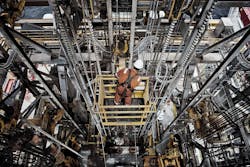Consortium aiming to re-purpose Danish North Sea fields for CO2 storage
Offshore staff
LYNGBY, Denmark – Maersk Drilling has agreed to join a new carbon dioxide (CO2) storage consortium formed by INEOS Oil & Gas Denmark and Wintershall Dea.
The partners are currently progressing a project concerning the development of CO2 storage capacity offshore Denmark, which involves re-using discontinued offshore oil and gas fields as a permanent CO2 store.
It has support from the Energy Technology Development and Demonstration Program, via the Danish Energy Agency. The Geological Survey of Denmark and Greenland will also serve as a research partner, undertaking laboratory experiments and analysis of results.
Maersk Drilling will contribute its experience and some funding to the project’s initial phases.
The plan is to build infrastructure and capabilities that will allow CO2 captured on land, i.e. at industrial or power plants, to be transported offshore for injection and storage 1,700 m (5,577 ft) beneath the seabed via repurposed oil and gas wells.
Initially, the CO2 will be bunkered in ports before being transported by ship to the offshore storage platform, which will re-use existing infrastructure originally built for oil and gas production.
Under the first phase, a feasibility study will validate reservoir compatibility, followed by a pilot to test CO2 injection. The target is to have the first well ready for injection from INEOS’ Nini platform in the North Sea in 2025.
A longer-term goal is to develop capacity to store around 3.5 MM metric tons/yr (3.86 MM tons) of CO2 by 2030, around 15-20% of the total reduction target for Denmark set by the Danish Climate Council and the government.
Maersk Drilling expects some of its offshore rigs to be used to re-purpose the existing oil and gas wells for CO2 injection.
CEO Jørn Madsen said: “For Maersk Drilling, the project is part of our innovation initiatives and an attractive opportunity for building additional competencies and broadening the use of our rigs.”
The company is also working on its own initiatives to reduce emissions associated with offshore drilling, including what it claims is the first-ever rig to operate on shore power, and the upgrade of two jackups to hybrid, low-emission units.
06/17/2020
